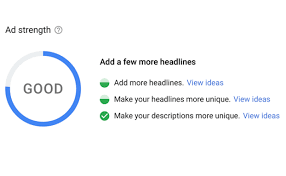After releasing responsive search adverts to PPC users, Google have released a new indicator to the 
Primarily, what the ad strength indicator does is assess how effective and good your responsive search advert is to getting the results you require: a click and a conversion. In a blog post by Google, they make clear that 91% of mobile users bought or plan to buy something after seeing an advert for which they deem relevant. This is an extremely high statistic that PPC advertisers should take on board. A more relevant and effective ad copy will ultimately mean better results in PPC. The ad strength indicator looks to help improve the ad copy for advertisers to improve campaign results.
The Ad Strength Indicator
The ad strength indicator looks to rate the ad copy of responsive search adverts from a score of ‘Poor’ to ‘Excellent’. In general, if you have an excellent ad copy, then your results through PPC should be better (with more conversions). If your ad copy is poor, then there will be many areas to improve upon your ad copy, for which Google will outline the main areas to look to improve next to the indicator.
The way this is done is by using Google’s machine learning algorithm to determine the best combinations of headlines and descriptions to produce the best results. By testing the possible different alterations, results will converge for best results.
As with any machine learning, it is therefore critical to make sure there is a lot of content for the machine learning algorithm to work with. If there are 5-10 possible combinations for headlines and descriptions, it won’t take long for the results to converge, where the results tend to not be impressive. The more headlines and descriptions you add to your responsive search advert, the more combinations and the higher the likelihood that your PPC campaign’s performance will increase. This is exactly why Google recommend having at least 5 headlines, although having more will further improve performance. The same is applicable with image adverts, where by having more images, headlines, logos and descriptions will generally improve the results of such adverts.
Conclusion
The ad strength indicator is a good addition by Google to further improve the performance of responsive search adverts, which they seem to think is the future of PPC. It is a tool that all advertisers that have search responsive adverts should use to further improve the effectiveness of such ad copies.
With this, just like with Ezoic, the more iterations there are for the machine learning to test, the better the results you will see. Although this will also mean it will take a little longer to reach the most effective results (potentially costing you more), in the long run, this will be worth the extra cost and time.




